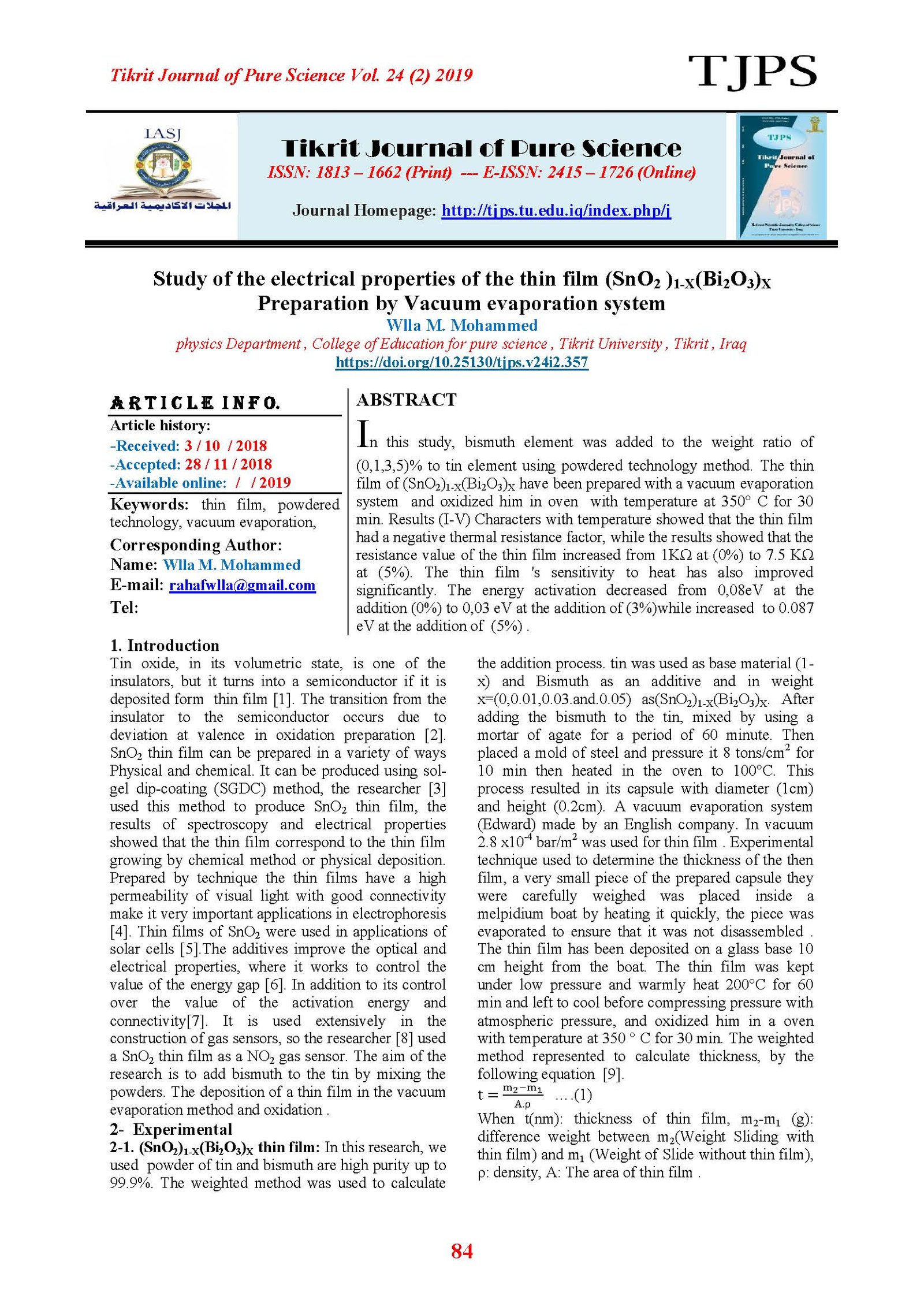Study of the electrical properties of the thin film (SnO2 )1-X(Bi2O3)X Preparation by Vacuum evaporation system
Main Article Content
Abstract
In this study, bismuth element was added to the weight ratio of (0,1,3,5)% to tin element using powdered technology method. The thin film of (SnO2)1-X(Bi2O3)X have been prepared with a vacuum evaporation system and oxidized him in oven with temperature at 350° C for 30 min. Results (I-V) Characters with temperature showed that the thin film had a negative thermal resistance factor, while the results showed that the resistance value of the thin film increased from 1KΩ at (0%) to 7.5 KΩ at (5%). The thin film 's sensitivity to heat has also improved significantly. The energy activation decreased from 0,08eV at the addition (0%) to 0,03 eV at the addition of (3%)while increased to 0.087 eV at the addition of (5%) .
Article Details

This work is licensed under a Creative Commons Attribution 4.0 International License.
Tikrit Journal of Pure Science is licensed under the Creative Commons Attribution 4.0 International License, which allows users to copy, create extracts, abstracts, and new works from the article, alter and revise the article, and make commercial use of the article (including reuse and/or resale of the article by commercial entities), provided the user gives appropriate credit (with a link to the formal publication through the relevant DOI), provides a link to the license, indicates if changes were made, and the licensor is not represented as endorsing the use made of the work. The authors hold the copyright for their published work on the Tikrit J. Pure Sci. website, while Tikrit J. Pure Sci. is responsible for appreciate citation of their work, which is released under CC-BY-4.0, enabling the unrestricted use, distribution, and reproduction of an article in any medium, provided that the original work is properly cited.
References
[1] Maa, J.; Haoa, X.; Huang, S. and Ma. H. (2003). Comparison of The Electrical and Optical Properties For SnO2:Sb Films Deposited on Polyimide and Glass Substrates. Applied Surface Science, 214: 208–213.
[2] Gorley, P. M.; Khomyak, V.; Bilichuk, S. V.; Orletsky, I. G. P. and Horley ,G. P. (2005). SnO2 Films:Formation, Electrical and Optical Properties. Material Science And Engineering B, 118: 160-163.
[3] Terrier, C.; Chatelon, J. J. and Roger, A. (1997). Electrical and optical properties of Sb:SnO2 thin films obtained by the sol-gel method. Thin Solid Films, 295 (1-2): 95-100.
[4] Cetinorgu, E.; Goldsmith, S.; Rosenberg, Y. and Boxmar. R. L. (2007). Influence of Annealing on The Physical Properties of Filtered Vacuum are Deposited Tin Oxide Thin Films. Journal of Non – Crystalline Solids, 353: 2595-2602.
[5] Elangovan, E. and Ramamurthi, K. ( 2003). Optoelectronic properties of spray deposited SnO2:F then films for window materials in solar cells. Journal of Optoelectronics and Advanced Materials, 5 (1): 45 – 54.
[5] Joseph, J.; Mathew, V. and Abraham, K. E. (2006). Physical Properties of Dy and La Doped SnO2 Thin Films Prepared by A Cost Effective Vapour Deposition Technique. Crystal Research Technol, 41 (10): 1020-1026.
[6] Mehcdi, B. M.; Mehrdad, M. and Saremi, S. ( 2004). The influence of Al doping on the electrical, optical and structural properties of SnO2 transparent conducting films deposited by the spray.pyrolysis technique. Journal Pyrolysis department Applied Pyrolysis, 37: 1248-1253.
[7] Dilip, L.; Kambleab, N. S.; Haralec,V. L. and Patil, L. (2017). Characterization and NO2 gas sensing properties of spray pyrolyzed SnO2 thin films. Journal of Analytical and Applied Pyrolysis, 127: 38-46.
(1) Ali ,I.; Ahmet, B. and Vaizogullar, L. (2014). Synthesis and Characterization of ZnO/SiO2 Core-Shell Microparticles and Photolytic Studies in Methylene Blue. International Journal of Research in Chemistry and Environment, 4(2): 161-165.
[8] Leontie, L.; Caraman, M.; Alexe, M. and Harnageac, C. (2002). Structural and optical characteristics of bismuth oxide thin films. Surface Science, 507 (510): 480-485.
[9] Volger, J. (1982). Optical properties of thin film solids. Journal of physical review, 20 (9): 1023.
[10] Chacko, S.; Sajeeth, N. P.; Gopchandran, K. G. and Peter, K. (2008). Nanostructural and Surface Morphological Evolution of Chemically Sprayed
SnO2 Thin Films. Applied Surface Science, 254: 2179–2186.
[11] Al Rashid, S. N. (2009). Preparation of SnO2 thin films and study of some of their electrical properties at different substrate and annealing temperatures. Anbar University Journal of Pure Sciences, 27: 1991-8941.
